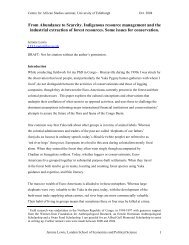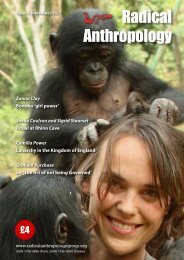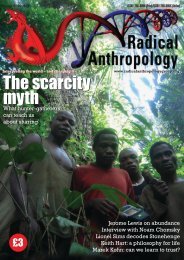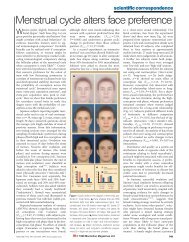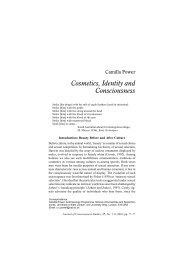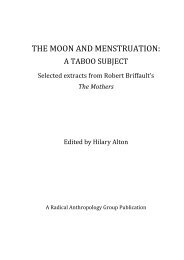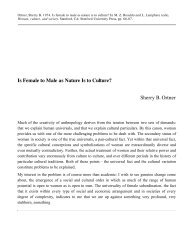Language and life history: A new perspective on the development ...
Language and life history: A new perspective on the development ...
Language and life history: A new perspective on the development ...
- No tags were found...
Create successful ePaper yourself
Turn your PDF publications into a flip-book with our unique Google optimized e-Paper software.
References/Locke & Bogin: <str<strong>on</strong>g>Language</str<strong>on</strong>g> <str<strong>on</strong>g>and</str<strong>on</strong>g> <str<strong>on</strong>g>life</str<strong>on</strong>g> <str<strong>on</strong>g>history</str<strong>on</strong>g>Galen, B. R. & Underwood, M. K. (1997) A <strong>development</strong>al investigati<strong>on</strong> ofsocial aggressi<strong>on</strong> am<strong>on</strong>g children. Developmental Psychology 33:589–600. [aJLL]Galik, K., Senut, B., Pickford, M., Gommery, D., Treil, J., Kuperavage, A. J. &Eckhardt, R. B. (2004) External <str<strong>on</strong>g>and</str<strong>on</strong>g> internal morphology of <strong>the</strong> BAR 1002’00Orrorin tugenensis femur. Science 305:1450–53. [RBE]Gangestad, S. & Snyder, M. (1986) On <strong>the</strong> nature of self-m<strong>on</strong>itoring: Anexaminati<strong>on</strong> of causal structure. Review of Pers<strong>on</strong>ality <str<strong>on</strong>g>and</str<strong>on</strong>g> Social Psychology6:65–85. [rJLL]Gärdenfors, P. (2003) How Homo became Sapiens: On <strong>the</strong> evoluti<strong>on</strong> of thinking.Oxford University Press. [SJ](2004) Cooperati<strong>on</strong> <str<strong>on</strong>g>and</str<strong>on</strong>g> <strong>the</strong> evoluti<strong>on</strong> of symbolic communicati<strong>on</strong>. In: Theevoluti<strong>on</strong> of communicati<strong>on</strong> systems, ed. K. Oller & U. Griebel, pp. 237–56.MIT Press. [SJ]Gardner, B. T. & Gardner, R. A. (1980) Two comparative psychologists look atlanguage acquisiti<strong>on</strong>. In: Child language, vol. 2, ed. K. Nels<strong>on</strong>, pp. 331–69.Gardner Press. [RAG](1989) Prelinguistic <strong>development</strong> of children <str<strong>on</strong>g>and</str<strong>on</strong>g> chimpanzees. HumanEvoluti<strong>on</strong> 4:433–60. [RAG](1998) Development of phrases in <strong>the</strong> early utterances of children <str<strong>on</strong>g>and</str<strong>on</strong>g>cross-fostered chimpanzees. Human Evoluti<strong>on</strong> 13:161–88. [RAG]Gardner, R. A. & Gardner, B. T. (1989) A cross-fostering laboratory. In: Teachingsign language to chimpanzees, ed.R. A. Gardner, B. T. Gardner & T. E. VanCantfort, pp. 1–28. State University of New York Press. [RAG]Gardner, R. A., Gardner, B. T. & Drumm, P. (1989) Voiced <str<strong>on</strong>g>and</str<strong>on</strong>g> signed resp<strong>on</strong>ses ofcross-fostered chimpanzees. In: Teaching sign language to chimpanzees, ed.R. A. Gardner, B. T. Gardner & T. E. Van Cantfort. State University ofNew York Press. [aJLL]Garrett, M. M. (1993) Wit, power, <str<strong>on</strong>g>and</str<strong>on</strong>g> oppositi<strong>on</strong>al groups: A case study of “puretalk.” Quarterly Journal of Speech 79:303–18. [aJLL]Garstang, W. (1922) The <strong>the</strong>ory of recapitulati<strong>on</strong>: A critical re-statement of <strong>the</strong>biogenetic law. Journal of <strong>the</strong> Linnaean Society of L<strong>on</strong>d<strong>on</strong> (Zoology)35:81–101. [DFB, aJLL]Gavan, J. A. (1953) Growth <str<strong>on</strong>g>and</str<strong>on</strong>g> <strong>development</strong> of <strong>the</strong> chimpanzee, a l<strong>on</strong>gitudinal<str<strong>on</strong>g>and</str<strong>on</strong>g> comparative study. Human Biology 25:93–143. [rJLL]Gibs<strong>on</strong>, K. R. & Ingold, T., eds. (1993) Tools, language <str<strong>on</strong>g>and</str<strong>on</strong>g> cogniti<strong>on</strong> in humanevoluti<strong>on</strong>. Cambridge University Press. [aJLL]Girolametto, L., Wiigs, M., Smyth, R., Weitzman, E. & Pearce, P. S. (2001)Children with a <str<strong>on</strong>g>history</str<strong>on</strong>g> of expressive vocabulary delay: Outcomes at 5 years ofage. American Journal of Speech-<str<strong>on</strong>g>Language</str<strong>on</strong>g> Pathology 10:358–69. [aJLL]Gleas<strong>on</strong>, J. B. & Weintraub, S. (1976) The acquisiti<strong>on</strong> of routines in child language.<str<strong>on</strong>g>Language</str<strong>on</strong>g> in Society 5:129–36. [aJLL]Goffman, I. (1969) The presentati<strong>on</strong> of self in everyday <str<strong>on</strong>g>life</str<strong>on</strong>g>. Penguin. [KK]Gogate, L. J., Bolzani, L. E. & Betancourt, E. (2006) Attenti<strong>on</strong> to maternalmultimodal naming by 6- to 8-m<strong>on</strong>th-old infants <str<strong>on</strong>g>and</str<strong>on</strong>g> learning of word-objectrelati<strong>on</strong>s. Infancy 9(3):259–88.[LJG]Gogate, L. J., Walker-Andrews, A. S. & Bahrick, L. E. (2001) The intersensoryorigins of word comprehensi<strong>on</strong>: An ecological-dynamic systems view.Developmental Science 4(1):1–18. [LJG]Gold, E. M. (1967) <str<strong>on</strong>g>Language</str<strong>on</strong>g> identificati<strong>on</strong> in <strong>the</strong> limit. Informati<strong>on</strong> <str<strong>on</strong>g>and</str<strong>on</strong>g> C<strong>on</strong>trol10:447–74. [DMWP]Goldin-Meadow, S. & Feldman, H. (1977) The <strong>development</strong> of language-likecommunicati<strong>on</strong> without a language model. Science 197:401–403. [aJLL]Goldin-Meadow, S. & Myl<str<strong>on</strong>g>and</str<strong>on</strong>g>er, C. (1998) Sp<strong>on</strong>taneous sign systems created bydeaf children in two cultures. Nature 391:279–81. [aJLL]Goldizen, A. W. (1987) Tamarins <str<strong>on</strong>g>and</str<strong>on</strong>g> marmosets: Communal care of offspring.In: Primate societies, ed. B. B. Smuts, D. L. Cheney, R. M. Seyfarth,R. W. Wrangham & T. T. Struhsaker, pp. 34–43. University of ChicagoPress. [GEW]Goldman, L. R. (1998) Child’s play: Myth, mimesis <str<strong>on</strong>g>and</str<strong>on</strong>g> make-believe. Berg. [SR]Goldstein, L., Byrd, D. & Saltzman, E. (in press) The role of vocal tract gesturalacti<strong>on</strong> units in underst<str<strong>on</strong>g>and</str<strong>on</strong>g>ing <strong>the</strong> evoluti<strong>on</strong> of ph<strong>on</strong>ology. In: Acti<strong>on</strong> tolanguage via <strong>the</strong> mirror neur<strong>on</strong> system, ed. M. A. Arbib. CambridgeUniversity Press. [aJLL]G<strong>on</strong>zález, J. (2004) Formant frequencies <str<strong>on</strong>g>and</str<strong>on</strong>g> body size of speaker: A weakrelati<strong>on</strong>ship in adult humans. Journal of Ph<strong>on</strong>etics 32:277–87. [aJLL]Goodall, J. (1968) The behaviour of free-living chimpanzees in <strong>the</strong> Gombe StreamReserve. Animal Behaviour M<strong>on</strong>ographs 1:165–311. [GEW](1983) Populati<strong>on</strong> dynamics during a 15 year period in <strong>on</strong>e community offree-living chimpanzees in <strong>the</strong> Gombe Nati<strong>on</strong>al Park, Tanzania. Zeitschriftfür Tierpsychologie 61:1–60. [aJLL](1988) In <strong>the</strong> shadow of man. Hought<strong>on</strong> Mifflin. [aJLL]Goodenough, J., McGuire, B. & Wallace, R. A. (1993) Perspectives in animalbehavior. Wiley. [RAG]Goody, J. & Watt, I. (1968) The c<strong>on</strong>sequences of literacy. In: Literacy in traditi<strong>on</strong>alsocieties, ed. J. Goody, pp. 27–68. Cambridge University Press. [rJLL]Gopnik, M. (1990) Feature-blind grammar <str<strong>on</strong>g>and</str<strong>on</strong>g> dysphasia. Nature344:715. [aJLL, LW](1997) <str<strong>on</strong>g>Language</str<strong>on</strong>g> deficits <str<strong>on</strong>g>and</str<strong>on</strong>g> genetic factors. Trends in Cognitive Science1:5–9. [LW]Gopnik, M. & Crago, M. B. (1991) Familial aggregati<strong>on</strong> of a <strong>development</strong>allanguage disorder. Cogniti<strong>on</strong> 39:1–50. [aJLL]Gossen, G. H. (1974) Chamulas in <strong>the</strong> world of <strong>the</strong> sun: Time <str<strong>on</strong>g>and</str<strong>on</strong>g> space in aMaya oral traditi<strong>on</strong>. Harvard University Press. [rJLL](1976a) Chamula genres of verbal behavior. In: Toward <str<strong>on</strong>g>new</str<strong>on</strong>g> <str<strong>on</strong>g>perspective</str<strong>on</strong>g>sin folklore, ed. A. Paredes & R. Bauman. University of Texas Press. [aJLL](1976b) Verbal dueling in Chamula. In: Speech play: Research <str<strong>on</strong>g>and</str<strong>on</strong>g> resources for<strong>the</strong> study of linguistic creativity, ed. B. Kirshenblatt-Gimblett, pp. 121–48.University of Pennsylvania Press. [arJLL]Gottlieb, G. (1992) Individual <strong>development</strong> <str<strong>on</strong>g>and</str<strong>on</strong>g> evoluti<strong>on</strong>: The genesis of novelbehavior. Erlbaum. [aJLL](2002) Developmental-behavioral initiati<strong>on</strong> of evoluti<strong>on</strong>ary change. PsychologicalReview 109:211–18. [DFB]Gottman, J., G<strong>on</strong>so, J. & Rasmussen, B. (1975) Social interacti<strong>on</strong>, socialcompetence, <str<strong>on</strong>g>and</str<strong>on</strong>g> friendship in children. Child Development46:709–18. [aJLL]Gottman, J. M. & Mettetal, G. (1986) Speculati<strong>on</strong>s about social <str<strong>on</strong>g>and</str<strong>on</strong>g> affective<strong>development</strong>: Friendship <str<strong>on</strong>g>and</str<strong>on</strong>g> acquaintance through adolescence. In: C<strong>on</strong>versati<strong>on</strong>sof friends: Speculati<strong>on</strong>s <strong>on</strong> affective <strong>development</strong>, ed. J. M. Gottman& J. G. Parker. Cambridge University Press. [aJLL]Gould, S. J. (1977) Ontogeny <str<strong>on</strong>g>and</str<strong>on</strong>g> phylogeny. Harvard University Press. [aJLL](1977) Ontogeny <str<strong>on</strong>g>and</str<strong>on</strong>g> Phylogeny. Harvard University Press/BelknapPress. [rJLL, SR]Gould, S. J. & Lew<strong>on</strong>tin, R. C. (1979) The sp<str<strong>on</strong>g>and</str<strong>on</strong>g>rels of San Marco <str<strong>on</strong>g>and</str<strong>on</strong>g> <strong>the</strong>Panglossian paradigm: A critique of <strong>the</strong> adapti<strong>on</strong>ist programme. Proceedingsof <strong>the</strong> Royal Society of L<strong>on</strong>d<strong>on</strong> B 205:581–98. [SR]Gouzoules, H. & Gouzoules, S. (2002) Primate communicati<strong>on</strong>: By natureh<strong>on</strong>est, or by experience wise? Internati<strong>on</strong>al Journal of Primatology23:821–48. [PK]Grammer, K. (1989) Human courtship behaviour: Biological basis <str<strong>on</strong>g>and</str<strong>on</strong>g> cognitiveprocessing. In: The sociobiology of sexual <str<strong>on</strong>g>and</str<strong>on</strong>g> reproductive strategies, ed. A. E.Rasa, C. Vogel & E. Vol<str<strong>on</strong>g>and</str<strong>on</strong>g>. Chapman <str<strong>on</strong>g>and</str<strong>on</strong>g> Hall. [aJLL](1990) Strangers meet: Laughter <str<strong>on</strong>g>and</str<strong>on</strong>g> n<strong>on</strong>verbal signs of interest in opposite-sexencounters. Journal of N<strong>on</strong>verbal Behavior 14:209–36. [aJLL]Grammer, K., Kruck, K., Juette, A. & Fink, B. (2000) N<strong>on</strong>verbal behaviour ascourtship signals: The role of c<strong>on</strong>trol <str<strong>on</strong>g>and</str<strong>on</strong>g> choice in selecting partners.Evoluti<strong>on</strong> <str<strong>on</strong>g>and</str<strong>on</strong>g> Human Behavior 21: 371–90. [aJLL]Grammer, K., Kruck, K. B. & Magnuss<strong>on</strong>, M. S. (1998) The courtship dance:Patterns of n<strong>on</strong>verbal synchr<strong>on</strong>izati<strong>on</strong> in opposite-sex encounters. Journal ofN<strong>on</strong>verbal Behavior 22:3–29. [aJLL]Grant, V. J. (2003) The maternal dominance hypo<strong>the</strong>sis: Questi<strong>on</strong>ing Trivers <str<strong>on</strong>g>and</str<strong>on</strong>g>Willard. Evoluti<strong>on</strong>ary Psychology 1:96–107. [SR]Greenspan, S. I. & Shanker, S. G. (2004) The first idea: How symbols, language, <str<strong>on</strong>g>and</str<strong>on</strong>g>intelligence evolved from our primate ancestors. Da Capo. [BJK]Grice, P. (1989) Studies in <strong>the</strong> way of words. Harvard University Press. [CK]Griebel, U. & Oller, D. K. (in press) Evoluti<strong>on</strong>ary forces favoring c<strong>on</strong>textual flexibility:Sexual selecti<strong>on</strong>, social cohesi<strong>on</strong>, decepti<strong>on</strong> <str<strong>on</strong>g>and</str<strong>on</strong>g> protean behavior. In:Evoluti<strong>on</strong> of communicative flexibility: Complexity, creativity <str<strong>on</strong>g>and</str<strong>on</strong>g> adaptabilityin human <str<strong>on</strong>g>and</str<strong>on</strong>g> animal communicati<strong>on</strong>, ed. D. K. Oller & U. Griebel.MIT Press. [DKO]Gurven, M., Allen-Arave, W., Hill, K. & Hurtado, M. (2000) “It’s a w<strong>on</strong>derful <str<strong>on</strong>g>life</str<strong>on</strong>g>”:Signaling generosity am<strong>on</strong>g <strong>the</strong> Ache of Paraguay. Evoluti<strong>on</strong> <str<strong>on</strong>g>and</str<strong>on</strong>g> HumanBehavior 21:263–82. [rJLL]Gurven, M. & Walker, R. (2006) Energetic dem<str<strong>on</strong>g>and</str<strong>on</strong>g> of multiple dependents <str<strong>on</strong>g>and</str<strong>on</strong>g> <strong>the</strong>evoluti<strong>on</strong> of slow human growth. Proceedings of <strong>the</strong> Royal Society of L<strong>on</strong>d<strong>on</strong> B273: 835–41. [rJLL]Gustafss<strong>on</strong>, J.-E. & Holmberg, L. M. (1992) Psychometric properties of vocabularytest items as a functi<strong>on</strong> of word characteristics. Sc<str<strong>on</strong>g>and</str<strong>on</strong>g>inavian Journal ofEducati<strong>on</strong>al Research 36:191–210. [aJLL]Gustafss<strong>on</strong>, J.-E. & Undheim, J. O. (1996) Individual differences in cognitivefuncti<strong>on</strong>s. In: H<str<strong>on</strong>g>and</str<strong>on</strong>g>book of educati<strong>on</strong>al psychology, ed. D. C. Berliner & R. C.Calfee. Macmillan. [aJLL]Haberl<str<strong>on</strong>g>and</str<strong>on</strong>g>, H. & Mey, J. L. (1977) Editorial: Linguistics <str<strong>on</strong>g>and</str<strong>on</strong>g> pragmatics. Journal ofPragmatics 1:1–12. [aJLL]Hadley, P. A. & Rice, M. L. (1991) C<strong>on</strong>versati<strong>on</strong>al resp<strong>on</strong>siveness of speech- <str<strong>on</strong>g>and</str<strong>on</strong>g>language-impaired preschoolers. Journal of Speech <str<strong>on</strong>g>and</str<strong>on</strong>g> Hearing Research34:1308–17. [aJLL]Haeckel, E. (1899) Riddle of <strong>the</strong> universe at <strong>the</strong> close of <strong>the</strong> nineteenthcentury. Available at: http://www.ucmp.berkeley.edu/<str<strong>on</strong>g>history</str<strong>on</strong>g>/haeckel.html. [LJG]Halpern, C. T., Udry, J. R., Campbell, B. & Suchindran, C. (1993) Testoster<strong>on</strong>e <str<strong>on</strong>g>and</str<strong>on</strong>g>pubertal <strong>development</strong> as predictors of sexual activity: A panel analysis ofadolescent males. Psychosomatic Medicine 55:436–47. [aJLL]Halpern, C. T., Udry, J. R. & Suchindran, C. (1998) M<strong>on</strong>thly measures of salivarytestoster<strong>on</strong>e predict sexual activity in adolescent males. Archives of SexualBehavior 27:445–65. [aJLL]316 BEHAVIORAL AND BRAIN SCIENCES (2006) 29:3



